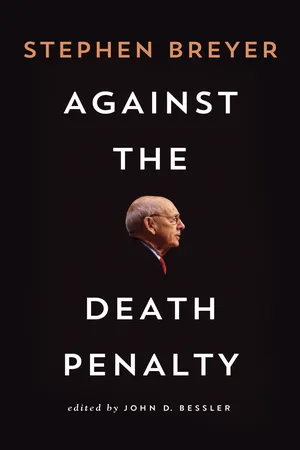![]()
NOTES
INTRODUCTION
1. Transcript of Oral Argument, Richard E. Glossip, et al. v. Kevin J. Gross, et al., No. 14-7955 (U.S. Supreme Court), at www.supremecourt.gov/oral_arguments/argument_transcripts/14-7955_1b72.pdf. [Ed. note: This book’s editor expresses his gratitude to two University of Baltimore law students, Valerie Bonk and Alex Powell, for their superb research assistance.]
2. Glossip v. State of Oklahoma, 29 P.3d 597, 598 (Okla. Ct. Crim. App. 2001); Glossip v. State of Oklahoma, 157 P.3d 143, 148–53 (Okla. Ct. Crim. App. 2007); Glossip v. Workman, No. CIV-08-0326-HE, 2010 WL 2196110 *1 (W.D. Okla., May 26, 2010); Samantha Vicent, Richard Glossip Case: Here’s the Story of His Victim, Tulsa World, Sept. 7, 2015, at www.tulsaworld.com/news/courts/richard-glossip-case-here-is-the-story-of-his-victim/article_1247f4c4-a8be-5492-b438-1c5d39c8b571.html.
3. Richard Glossip Talking Points, at www.sisterhelen.org/wordpress/wp-content/uploads/Richard_Glossip_talking_points.pdf.
4. Glossip, 29 P.3d at 598–603; Glossip, 157 P.3d at 147–64; id. at 173 (Chapel, J., dissenting). Initially, the state of Oklahoma charged Richard Glossip with being an accessory after the fact to murder, but then it dismissed the accessory information and added Glossip as a codefendant with Sneed on the murder charge. Id. at 157. In his 2001 appeal, Glossip had successfully argued that he was entitled to a jury instruction on the crime of accessory after the fact. Glossip, 29 P.3d at 603.
5. Warner v. Gross, No. CIV-14-0665-F, 2014 WL 7671680 (W.D. Okla., Dec. 2014).
6. Warner v. Gross, 135 S. Ct. 824 (2015) (Sotomayor, J., dissenting).
7. Id.
8. Id.
9. M. Delatorre, Ed Doney, & Abby Broyles, Oklahoma Inmate Said His “Body Was on Fire” Prior to Being Executed for 1997 Murder and Rape, KFOR.com, Jan. 15, 2015, at http://kfor.com/2015/01/15/oklahoma-inmate-said-his-body-was-on-fire-prior-to-be-executed-for-1997-murder-and-rape; Nolan Clay & Rick Green, Wrong Drug Used for January Execution, State Records Show, The Oklahoman, Oct. 8, 2015, at http://newsok.com/wrong-drug-used-for-january-execution-state-records-show/article/5452084.
10. Glossip v. Gross, 135 S. Ct. 2726, 2733 (2015).
11. James Gibson & Corinna Barrett Lain, Death Penalty Drugs and the International Moral Marketplace, 103 GEORGETOWN L.J. 1215, 1242 (2015).
12. European Commission, Press Release Database, Commission Extends Control over Goods Which Could Be Used for Capital Punishment or Torture (Brussels, Dec. 20, 2011), at http://europa.eu/rapid/press-release_IP-11-1578_en.htm.
13. Protocol No. 6 to the Convention for the Protection of Human Rights and Fundamental Freedoms Concerning the Abolition of the Death Penalty, ETS 114 (Apr. 28, 1983; entered into force Mar. 1, 1985), Art. 1; Protocol No. 13 to the Convention for the Protection of Human Rights and Fundamental Freedoms Concerning the Abolition of the Death Penalty in All Circumstances, ETS 187 (May 3, 2002; entered into force July 1, 2003), Art. 1.
14. Andrew Drilling, Capital Punishment: The Global Trend Toward Abolition and Its Implications for the United States, 40 OHIO N.U. L. REV. 847, 865 (2014).
15. Linda Greenhouse, Becoming Justice Blackmun: Harry Blackmun’s Supreme Court Journey (New York: Times Books, 2005), p. 167.
16. Warner, 135 S. Ct. at 826–27 (Sotomayor, J., dissenting).
17. Cary Aspinwall, Charles Warner Is Executed, Tulsa World, Jan. 14, 2015, at www.tulsaworld.com/news/courts/charles-warner-is-executed-here-s-the-story-of-his/article_af39c542-08d0-5bd6-80ac-01a6f1c668ee.html; Cary Aspinwall & Ziva Branstetter, Oklahoma Executes Charles Warner in 20-minute Procedure; State Says No Complications, Tulsa World, Jan. 16, 2015, at www.tulsaworld.com/newshomepage1/oklahoma-executes-charles-warner-in--minute-procedure-state-says/article_134dd8b3-0024-574e-a732-f3b466274f1c.html; Dana Ford, Oklahoma Executes Charles Warner, CNN, Jan. 16, 2015, at www.cnn.com/2015/01/15/us/oklahoma-execution-charles-frederick-warner.
18. John F. Stinneford, Death, Desuetude, and Original Meaning, 56 WM. & MARY L. REV. 531, 539–40 (2014) (“Justice Antonin Scalia is the most prominent advocate of the position that, absent constitutional amendment, the death penalty can never be declared unconstitutional consistent with the original meaning of the Cruel and Unusual Punishments Clause.”); id. at 542 (“Justice Scalia appears to believe that the Cruel and Unusual Punishments Clause is a positive legal norm that forbids only those punishments that violate the standards of cruelty that prevailed in 1791.”); Steven G. Gey, Justice Scalia’s Death Penalty, 20 FLA. ST. U. L. REV. 67, 129 (1992) (“Scalia’s basic principle is simply that ‘the People’ are permitted to decide ‘what is a crime and what constitutes aggravation and mitigation of a crime.’ In other words, if ‘the People’ want to use the death penalty, then no further utilitarian proof, support, or justification is necessary.”) (quoting Payne v. Tennessee, 111 S. Ct. 2597, 2613 (1991) (Scalia, J., concurring)).
19. Transcript of Oral Argument (Apr. 29, 2015), Glossip v. Gross, supra note 1, at pp. 3–20; Austin Sarat, The Trouble with Oklahoma’s New Execution Technique, Politico Magazine, Apr. 20, 2015, at www.politico.com/magazine/story/2015/04/oklahoma-death-penalty-gas-chamber-117156.
20. In re Kemmler, 136 U.S. 436, 446 (1890); Wilkerson v. Utah, 99 U.S. 130, 134–36 (1879); see also Weems v. United States, 217 U.S. 349, 404 (1910) (White, J., dissenting) (“So long as they do not provide cruel and unusual punishments, such as disgraced the civilization of former ages, and made one shudder with horror to read of them, as drawing, quartering, burning, etc., the Constitution does not put any limit upon legislative discretion.”); Glass v. Louisiana, 471 U.S. 1080, 1084 (1985) (Brennan, J., dissenting from denial of cert.) (“in explaining the obvious unconstitutionality of such ancient practices as disemboweling while alive, drawing and quartering, public dissection, burning alive at the stake, crucifixion, and breaking at the wheel, the Court has emphasized that the Eighth Amendment forbids ‘inhuman and barbarous’ methods of execution that go at all beyond ‘the mere extinguishment of life’ and cause ‘torture or a lingering death’ ”) (citing In re Kemmler, 136 U.S. at 447); Baze v. Rees, 553 U.S. 35, 101 (2008) (Thomas, J., dissenting) (“It strains credulity to suggest that the defining characteristic of burning at the stake, disemboweling, drawing and quartering, beheading, and the like was that they involved risks of pain that could be eliminated by using alternative methods of execution. Quite plainly, what defined these punishments was that they were designed to inflict torture as a way of enhancing a death sentence; they were intended to...
